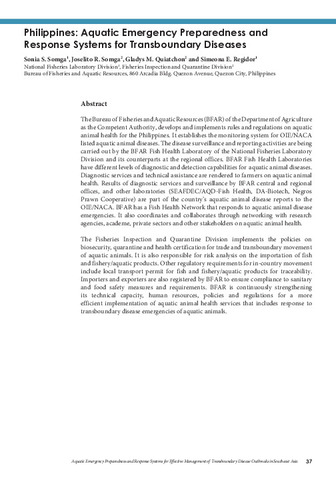Perlihatkan publikasi sederhana
Emergency response to emerging diseases: TiLV in tilapia
| dc.contributor.author | Senapin, Saengchan | |
| dc.contributor.editor | Tendencia, Eleonor A. | |
| dc.contributor.editor | de la Peña, Leobert D. | |
| dc.contributor.editor | de la Cruz, Joesyl Marie V. | |
| dc.date.accessioned | 2019-07-23T08:09:34Z | |
| dc.date.available | 2019-07-23T08:09:34Z | |
| dc.date.issued | 2019 | |
| dc.identifier.citation | Senapin, S. (2019). Emergency response to emerging diseases: TiLV in tilapia. In E. A. Tendencia, L. D. de la Peña, & J. M. V. de la Cruz (Eds.), Aquatic Emergency Preparedness and Response Systems for Effective Management of Transboundary Disease Outbreaks in Southeast Asia: Proceedings of Asean Regional Technical Consultation, 20-22 August 2018, Centara Grand Central Ladprao, Bangkok, Thailand (pp. 81-83). Tigbauan, Iloilo, Philippines: Aquaculture Department, Southeast Asian Fisheries Development Center. | en |
| dc.identifier.isbn | 9789719931089 | |
| dc.identifier.uri | http://hdl.handle.net/10862/3468 | |
| dc.description.abstract | Tilapia lake virus (TiLV) is a novel RNA virus resembling Orthomyxovirus. It has been recently re-classified to Tilapia tilapinevirus species, under Tilapinevirus genus, Amnoonviridae family (ICTV, 2018). Since the first discovery in Israel in 2014, so far TiLV has been reported from 14 countries in three continents (Asia, Africa, and South America). Thailand is one of the affected countries that reported emergence of this virus in 2017. Initially, we employed nested RT-PCR primer sequences previously published for TiLV diagnosis. However, the resulting amplification of nonspecific fish genes led us to modify the nested RT-PCR protocols into a semi-nested RT-PCR by omitting a non-specific primer to avoid false positive results. Subsequently, our molecular work together with histopathology and sequence analysis confirmed the presence of TiLV infection in Thailand. Prior to the publication of our manuscript, we informed the Thai Department of Fisheries of our discovery of TiLV in Thailand. Our publication was preceded by a brief article at the website of the Network of Aquaculture Centers in Asia-Pacific in which we warned of the spread of TiLV and offered free use of a newly improved, semi-nested RT-PCR method and positive control plasmid for detection of TiLV. To date, we have provided positive controls in response to 44 requests from 24 countries who have expressed their appreciation for our attempt to help in emergent controlling the spread of this fish pathogen. Our current study focuses on genetic diversity of TiLV and development of detection method that covers all genetic variants. | en |
| dc.language.iso | en | en |
| dc.publisher | Aquaculture Department, Southeast Asian Fisheries Development Center | en |
| dc.subject | Vibrio parahaemolyticus | en |
| dc.subject | Asia | en |
| dc.subject | Thailand | en |
| dc.subject | Tilapia tilapinevirus | en |
| dc.title | Emergency response to emerging diseases: TiLV in tilapia | en |
| dc.type | Conference paper | en |
| dc.citation.spage | 81 | |
| dc.citation.epage | 83 | |
| dc.citation.conferenceTitle | Aquatic Emergency Preparedness and Response Systems for Effective Management of Transboundary Disease Outbreaks in Southeast Asia: Proceedings of Asean Regional Technical Consultation, 20-22 August 2018, Centara Grand Central Ladprao, Bangkok, Thailand | en |
| dc.subject.asfa | disease control | en |
| dc.subject.asfa | disease recognition | en |
| dc.subject.asfa | disease resistance | en |
| dc.subject.asfa | disease transmission | en |
| dc.subject.asfa | epidemiology | en |
| dc.subject.asfa | husbandry diseases | en |
| dc.subject.asfa | aquaculture regulations | en |
| dc.subject.asfa | quarantine regulations | en |
| dc.subject.asfa | fish culture | en |
| dc.subject.asfa | fish diseases | en |
| dc.subject.asfa | freshwater aquaculture | en |
| dc.subject.asfa | freshwater fishes | en |
| dc.subject.asfa | viral diseases | en |
| dc.subject.asfa | infectious diseases | en |
| dc.subject.asfa | virology | en |
| dc.subject.asfa | viruses | en |
| dc.subject.asfa | genetics | en |
| dc.subject.asfa | emergencies | en |
| dc.subject.asfa | freshwater | en |
| dc.subject.asfa | hepatopancreas | en |
| dc.subject.asfa | polymerase chain reaction | en |
| dc.subject.asfa | fisheries | en |
| dc.subject.asfa | genes | en |
| dc.subject.asfa | fish | en |
| dc.subject.asfa | nucleic acids | en |
| dc.subject.asfa | lakes | en |
| dc.subject.asfa | pathogens | en |
| dc.subject.asfa | protocols | en |
| dc.subject.asfa | RNA | en |
| dc.subject.asfa | aquaculture | en |
| dc.subject.asfa | histopathology | en |
| dc.subject.asfa | detection | en |
| dc.subject.asfa | nucleotide sequence | en |
| dc.subject.asfa | plasmids | en |
| dc.subject.asfa | DNA | en |
| dc.subject.asfa | inland waters | en |
| dc.subject.asfa | genetic variation | en |
| dc.subject.asfa | countries | en |
| dc.subject.scientificName | Vibrio campbellii | en |
| dc.subject.scientificName | Vibrio harveyi | |
| dc.subject.scientificName | Vibrio owensii | en |
| dc.subject.scientificName | Amnoonviridae | en |
Files in this item
Publikasi ini ada di koleksi berikut
-
Aquatic Emergency Preparedness and Response Systems for Effective Management of Transboundary Disease Outbreaks in Southeast Asia [20]
Proceedings of ASEAN Regional Technical Consultation, 20-22 August 2018, Centara Grand Central Ladprao, Bangkok, Thailand





